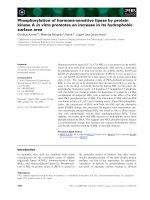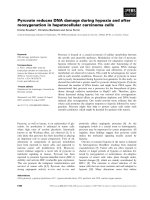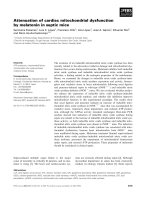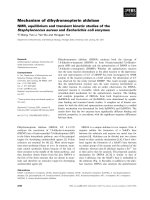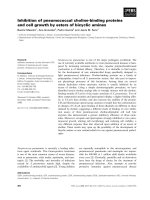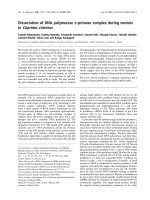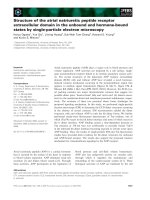Báo cáo khoa học: "Concentrations of cardiac Troponin I before and after ovariohysterectomy in 46 female dogs with pyometra" pdf
Bạn đang xem bản rút gọn của tài liệu. Xem và tải ngay bản đầy đủ của tài liệu tại đây (269.73 KB, 8 trang )
BioMed Central
Page 1 of 8
(page number not for citation purposes)
Acta Veterinaria Scandinavica
Open Access
Research
Concentrations of cardiac Troponin I before and after
ovariohysterectomy in 46 female dogs with pyometra
Lena Pelander*
1,2
, Ragnvi Hagman
2
and Jens Häggström
2
Address:
1
University Teaching Hospital, Swedish University of Agricultural Science, Uppsala, Sweden and
2
Department of Clinical Sciences,
Swedish University of Agricultural Science, Uppsala, Sweden
Email: Lena Pelander* - ; Ragnvi Hagman - ; Jens Häggström -
* Corresponding author
Abstract
Background: Canine pyometra is a common disease in countries where routine spaying of young dogs is
not common practice. This disease is known to lead to systemic inflammation potentially affecting multiple
organs in the body, including the heart. Cardiac-specific Troponin I (cTnI) is a sensitive marker of
myocardial cell damage, which can result from ischemia, trauma, toxins or inflammation. Dogs with
pyometra are also exposed to anaesthesia which can potentially result in myocardial cell damage. The aims
of the study were 1) to evaluate the occurrence of myocardial cell damage as indicated by increased serum
concentrations of cTnI in dogs with pyometra and relate these to presence of systemic inflammation and
2) to evaluate the change in cTnI-concentrations after anaesthesia and surgery.
Methods: Serum cTnI concentration was measured preoperatively and one day after surgery in 46 female
dogs with pyometra and 15 female dogs that underwent surgery for other reasons (ovariohysterectomy
and mammary tumours).
Results: Forty-six female dogs of different breeds diagnosed with pyometra were included. The dogs had
a median age of 8.5 years (IQR 7.5–10) and a median weight of 29 kg (IQR 9–32). Of the 46 dogs, 37 (80%)
fulfilled the chosen criteria for systemic inflammatory response syndrome (SIRS) at inclusion. Thirteen
(28%) of the dogs had increased cTnI concentrations (> 0.2 μg/l) before surgery and 18 (39%) had
increased cTnI-concentrations the day after surgery. The cTnI concentrations in the 13 dogs with
increased preoperative cTnI concentrations decreased in 8 dogs, increased in 4 dogs, and was unchanged
in one dog. Seven dogs with nondetectable preoperative cTnI concentrations had increased postoperative
concentrations. The only significant association between the studied laboratory or clinical variables
(including SIRS) and cTnI concentration was preoperative percentage band neutrophils (PBN) and
postoperative cTnI concentration (P = 0.016). In total, 20 dogs (43%) had increased pre- or postoperative
cTnI concentrations. Seven dogs (15%) had pre-or postoperative concentrations of cTnI of 1.0 μg/l or
higher.
Conclusion: Mild to moderate increases in cTnI appears to be common in dogs with pyometra before
and after surgery, but the clinical importance of this finding is uncertain. None of the studied clinical
variables were found to reliably predict increased preoperative cTnI concentrations. Because of the pre-
and postoperative variation in cTnI concentrations, it was not possible to identify a negative effect of
anaesthesia and surgery on myocardial cell integrity.
Published: 11 September 2008
Acta Veterinaria Scandinavica 2008, 50:35 doi:10.1186/1751-0147-50-35
Received: 17 March 2008
Accepted: 11 September 2008
This article is available from: />© 2008 Pelander et al; licensee BioMed Central Ltd.
This is an Open Access article distributed under the terms of the Creative Commons Attribution License ( />),
which permits unrestricted use, distribution, and reproduction in any medium, provided the original work is properly cited.
Acta Veterinaria Scandinavica 2008, 50:35 />Page 2 of 8
(page number not for citation purposes)
Background
Myocardial damage can be caused by multiple conditions
including ischemia, trauma, toxins or inflammation. Car-
diac-specific Troponin I (cTnI) is currently the most sensi-
tive and specific marker of myocardial cell damage in the
dog [1,2]. Cardiac-specific Troponin I is a protein that is
expressed at high concentrations only in the myocardium.
When cardiac myocytes are damaged, cTnI leaks into the
bloodstream and can be detected in serum [1,3]. In nor-
mal dogs serum concentrations of cTnI are low or, most
often, undetectable [4].
Canine pyometra is a common disease in countries where
routine spaying of young dogs is not common practice.
The condition may cause systemic inflammation, which
may potentially damage multiple organs in the body,
including the heart [5]. The presence of systemic inflam-
matory response syndrome (SIRS) may be predicted by
certain clinical and laboratory parameters [6]. The sys-
temic inflammation can, if not successfully treated,
progress to multiple organ dysfunction syndrome
(MODS) and death [7].
The safest and most effective treatment for canine pyome-
tra is ovariohysterectomy [8]. However, anaesthesia and
surgery may cause myocardial ischemia with subsequent
myocardial cell damage, especially in individuals with sys-
temic inflammation and impaired circulation [9]. In
humans, the occurrence of perioperative ECG abnormali-
ties and "silent myocardial ischemia" is well recognised
[10]. One study documented myocardial ischemia 12
hours postoperatively (as measured by increased concen-
trations of cTnI) in healthy women undergoing caesarean
section [11]. It has been demonstrated that perioperative
elevations of cTnI concentrations were associated with
major cardiac complications up to 1 year after surgery
[12].
Thus, myocardial injury is a potential cause of increased
morbidity and mortality in dogs with pyometra before,
during and after surgery. However, there are no reports
concerning the occurrence and significance of periopera-
tive myocardial damage in dogs undergoing anaesthesia
irrespective of the underlying condition. The presence of
myocardial damage may often be overlooked and difficult
to detect when suspected if it does not lead to compro-
mised cardiac function, arrhythmias or regional abnormal
ventricular motion. Analysis of the serum concentration
of cTnI can reveal both clinical and subclinical damage to
the myocytes [9,13].
The aims of the present study were 1) to evaluate the
occurrence of myocardial cell damage as indicated by
increased serum concentrations of cTnI in dogs with pyo-
metra and relate these to the severity of systemic inflam-
mation and other clinical variables and 2) to evaluate the
change in cTnI concentrations after anaesthesia and sur-
gery.
Materials and methods
This study was approved by the Uppsala County local eth-
ical committee.
Dogs
Forty-six female dogs diagnosed with pyometra were
recruited to the study at the Department of Small Animal
Clinical Sciences, Swedish University of Agricultural Sci-
ences (SLU), Uppsala between January 2004 and Decem-
ber 2005. At the time of arrival, a physical examination
was performed on dogs presenting with a history compat-
ible with pyometra (polyuria, polydipsia, anorexia, vom-
iting, lethargy, fever, vulvar discharge, recent oestrus).
Blood samples analysed for complete blood count (CBC)
and cardiac-specific Troponin I (cTnI) were collected and
radiography and/or ultrasonography of the abdomen was
performed, and dogs diagnosed with pyometra were
included in the study. Dogs whose owners did not agree
to ovariohysterectomy, and dogs with clinical or labora-
tory findings indicative of other organ-related or systemic
disease were excluded from the study. Recorded data
obtained from the case history and physical examination
included age, weight, rectal temperature, heart rate and
respiratory rate. A second serum sample for analysis of
cTnI was collected 12–24 hours after surgery.
Fifteen female dogs undergoing surgery for neutering (n =
12) or tumour mammae (n = 3) were recruited as control
dogs. None of these dogs had a history or clinical signs
indicative of other disease, and in the case of tumour
mammae thoracic radiographs had shown that the dogs
were free of visible pulmonary metastases. A physical
examination was performed on all of these control dogs.
Serum for analysis of cTnI was collected at presentation
and 12–24 hours after surgery.
Diagnosis of pyometra
Abdominal radiography and/or ultrasonography were
performed on all dogs. The radiological examination
included left and ventrodorsal projections of the entire
abdomen using the standard procedure at the Section for
Diagnostic Imaging, Department of Clinical Sciences,
SLU, Sweden. The diagnosis of pyometra was established
when an enlarged (and, if ultrasonography was per-
formed, fluid-filled) uterus was found, as previously
described [14,15]. The diagnosis was confirmed by the
presence of an enlarged uterus containing pus during the
surgical procedure.
Acta Veterinaria Scandinavica 2008, 50:35 />Page 3 of 8
(page number not for citation purposes)
Diagnosis of inflammatory response syndrome (SIRS)
Dogs were grouped into two groups; SIRS-positive and
SIRS-negative. Dogs that fulfilled two or more of the fol-
lowing criteria were considered SIRS-positive: 1) Resting
heart rate > 120/min; 2) respiratory rate > 20/min; 3) rec-
tal temperature above 39.2°C or below 38.1°C; and 4)
total white blood cell count (WBC) above 16 × 10
9
or
below 6 × 10
9
cells per l blood or more than 3% band neu-
trophils [6].
Sample handling
Blood samples for hematological and biochemical analy-
sis were taken from the distal cephalic vein into EDTA and
serum Vacutainer
®
tubes (Becton & Dickinson, Meylon
Cedex, France) and transported to the laboratory for anal-
ysis within one hour of collection.
Ovariohysterectomy
The dogs were premedicated with glycopyrrulate, metha-
done, acepromazine and carprofen. Anaesthesia was
induced with propofol and maintained with isoflurane. In
dogs that were considered an anaesthetic risk because of a
severely compromised general condition (n = 5) anaesthe-
sia was induced with diazepam and ketaminol and main-
tained with isoflurane. Ovariohysterectomy was
performed using a standard ventral midline approach
[16]. The procedure was performed within 24 hours in all
dogs except one. The owners wished to delay surgery until
after the weekend in this dog because of a good general
condition. All dogs were treated with iv fluids before, dur-
ing and after surgery. Approximately half of the dogs were
treated with antibiotics perioperatively. All dogs received
preoperative and postoperative opioids until discharge.
No medications were given before the preoperative blood
samples were collected.
Haematology, cTnI analysis and blood biochemistry
The CBC was performed using Abbott CELL-DYN 3500
(Abbott Diagnostics, Illinois, USA) in combination with
manual microscopy in all cases except eight, where the
haematology was performed using the QBC Vet Autoread
(IDEXX Laboratories, Maine, USA). In these eight cases
the CBC was performed in an emergency situation when
the QBC Vet Autoread was the only option for analysis of
haematology.
Troponin I was analyzed using a commercially available
method (IMMULITE Troponin I, Diagnostic Products
Corporation, Los Angeles, USA). This is an immunometric
method where antibodies raised against human cTnI bind
to existing cTnI in the sample. The lower limit of detection
for the cTnI assay is 0,2 μg/l. The possibility of using this
method for detection of cTnI in serum samples from dogs
was investigated in an earlier study [17,18]. The upper ref-
erence limit for normal dogs in our laboratory was 0.2 μg/
l.
Adjunct serum biochemical analyses were not included in
the study protocol but were performed in some cases, pre-
operatively (Table 1). ALT, ALP, creatinine and glucose
were analyzed using a commercially available method
(IDEXX VET TEST Chemistry Analyzer, IDEXX Laborato-
ries, Maine, USA).
Statistics
All statistical analyses were performed using a statistical
programme (JMP v 5.0, SAS, Cary, USA). Serum concen-
trations of cTnI from SIRS-positive and SIRS-negative dogs
were compared using Wilcoxon Rank Sum Test.
The association between cTnI concentrations and haema-
tological and blood-biochemical variables, and variables
obtained from the physical examination were evaluated
by a Spearman rank correlation. Values are reported as the
median and interquartile range (IQR). The significance
level was set at p < 0.05.
Results
Dogs with pyometra
The median age of the 46 dogs with pyometra at presenta-
tion was 8.5 years (IQR 7.5–10) and median body weight
29 kg (IQR 9–32). The group comprised 8 mongrel dogs
and 38 dogs of 22 different breeds.
Control dogs
The median age of the dogs in the control group was 5
years (IQR 2–8). Median body weight was 27 kg (IQR
20–32). The group comprised 3 mongrel dogs and 12
dogs of 12 different breeds.
Table 1: Median and interquartile ranges (IQR) of preoperative plasma biochemical variables (ALT, ALP, creatinine and glucose
concentrations) in the study population of dogs with pyometra.
Biochemical variable Median IQR Reference interval
ALT (u/l) (n = 27) 16 10–36 10–100
ALP (u/l) (n = 23) 162 87–229 23–212
Creatinine (μmol/l) (n = 33) 82 67–100 44–159
Glucose (mmol/l) (n = 20) 6.8 5.9–7.1 4.3–6.9
Acta Veterinaria Scandinavica 2008, 50:35 />Page 4 of 8
(page number not for citation purposes)
Preoperative cTnI-concentrations
All of the dogs in the control group had undetectable pre-
operative cTnI concentrations (Table 2). Of the 46 dogs
with pyometra, 13 (28%) had increased preoperative cTnI
concentrations (range 0.3–13.2 μg/l) (Table 3).
Postoperative cTnI concentrations
Two (13%) of the control dogs had increased cTnI con-
centrations the day after surgery (0.4 and 3 μg/l, respec-
tively) (Table 2). Eighteen (39%) of the pyometra dogs
had increased postoperative cTnI concentrations (range
0.3–6.4 μg/l) (Table 3). Of the 13 dogs with increased pre-
operative cTnI concentrations, 8 had lower, 4 had
increased, and one had unchanged cTnI concentrations
after surgery. In seven dogs with nondetectable cTnI con-
centrations at presentation, increased levels were demon-
strated postsurgically.
Thus, in total, 20 dogs (43%) with pyometra had
increased cTnI concentrations before or after surgery, and
7 dogs had pre- or postoperative cTnI concentrations of
1.0 μg/l or higher.
Preoperative blood biochemistry
None of the 27 dogs that had serum ALAT concentration
analysed had a concentration exceeding the upper refer-
ence range. Similarly, only one out of the 33 dogs that had
serum creatinine concentration analysed had a concentra-
tion exceeding the upper reference range for creatinine.
Finally, 6 of the 23 dogs that had serum ALP concentra-
tion and 6 out of the 20 dogs that had serum glucose con-
centration analysed had a concentration exceeding the
upper reference range.
SIRS groups and outcome
Eleven of the dogs with pyometra fulfilled all four SIRS
criteria. Ten of the dogs fulfilled three criteria, 16 dogs ful-
filled two criteria and 6 dogs one criterion for SIRS. Three
dogs did not fulfil any of the SIRS criteria. Consequently
the SIRS-positive group (two or more positive criteria)
consisted of 37 dogs (80%) and the SIRS-negative group
of 9 dogs (20%). All dogs except four were discharged
within 48 hours of surgery. Reasons for delaying discharge
in four dogs were resuturing of skin wound (n = 1),
reduced general condition postoperatively (n = 1) and
owner preference (n = 2). All dogs in the study recovered
and survived the postoperative period (10 days).
Comparison of cTnI concentrations and clinical
parameters
When the SIRS-positive and SIRS-negative groups were
compared (both before and after surgery) there was no
statistically significant difference in cTnI concentrations
between the groups. The only significant association
between the studied laboratory or clinical variables and
cTnI concentration was preoperative percentage band
neutrophils (PBN) and postoperative cTnI concentration
(p = 0.016) (Figure 1). The preoperative PBN tended to be
correlated with preoperative cTnI concentrations (p =
0.059).
Discussion
In total, 20 out of 46 dogs (43%) with pyometra had
increased concentrations of cTnI at some time during the
study, which indicates that increased cTnI concentrations
are common during the perioperative period in dogs with
pyometra. This finding is supported by the results of our
previous study in which increased preoperative cTnI con-
centrations were documented in 12% of 58 dogs with
pyometra [18]. The present study is different from our pre-
Table 2: Age, weight, reason for surgery (n = neutering, tm = tumor mammae) and pre-and post-operative serum cTnI-concentrations
in 15 female dogs undergoing elective surgery (control group).
Case No Age (years) Weight (kg) Reason for surgery Pre-operative cTnI (μg/l) Post-operative cTnI (μg/l)
19 28 n < 0.2 < 0.2
24 38 n < 0.2 < 0.2
36 22 n < 0.2 < 0.2
44 8 n < 0.2 0.4
55 20 n < 0.2 < 0.2
69 31 tm < 0.2 < 0.2
78 18 tm < 0.2 < 0.2
87 22 n < 0.2 < 0.2
99 10 tm < 0.2 < 0.2
10 4 35 n < 0.2 3.0
11 5 32 n < 0.2 < 0.2
12 1 57 n < 0.2 < 0.2
13 1 26 n < 0.2 < 0.2
14 1 27 n < 0.2 < 0.2
15 2 30 n < 0.2 < 0.2
Acta Veterinaria Scandinavica 2008, 50:35 />Page 5 of 8
(page number not for citation purposes)
vious one because, to our knowledge, this is the first study
that documents both pre-and postoperative measure-
ments of cTnI concentrations in dogs with pyometra. It
should be pointed out that only 7 of the 20 dogs with
increased concentrations of cTnI (10 out of the total 31
samples with increased concentrations) had values ≥ 1.0
μg/l and none of the dogs measured higher than 13.2 μg/
ml, indicating that cTnI concentrations were mildly
increased in the majority of cases. The lower limit of
detection of cTnI in our assay is 0,2 μg/l. It is possible that
the upper reference range for cTnI in dogs is lower than
0,2 μg/l and that a greater number of dogs would have had
Table 3: Weight, age, white blood cell count (WBC), percentage band neutrophils (PBN), heart rate (HR), rectal temperature,
respiratory rate (RR) above 20/min or not, pre-and post-operative cTnI-concentrations for 46 dogs with pyometra.
Case No Weight
(kg)
Age
(years)
WBC
(×109/ml)
Neutrophils
(×109/ml)
PBN (%) HR (bpm) Temp (°C) RR >20 Pre-op
cTnI (μg/l)
Post-op
cTnI (μg/l)
SIRS-pos
1 32 6.5 32 1.8 72 120 39.1 Y 13.2 6.4 +
2 7 11.5 7 - - 128 40.4 Y < 0.2 < 0.2 +
3 11 7 11.4 5.9 0 80 38.6 Y < 0.2 < 0.2 -
4 28 11 28 6.9 89 104 39.6 - 0.7 0.7 +
5 11 8 11.3 10.9 12 - 39.9 - 1.2 0.4 +
6 33 10 33.5 9.7 0 110 38.8 Y < 0.2 0.3 -
7 29 3.5 29 - - 140 39.3 Y < 0.2 < 0.2 +
8 30 8.5 30 15.5 43 144 39.9 N 2.0 1.0 +
9 12 13 12 26.8 91 - 38.3 N 0.3 0.4 +
10 10 12.5 9.7 1.6 12 134 39.9 N < 0.2 < 0.2 +
11 27 7.5 26.6 - - 128 39.4 N < 0.2 0.4 +
12 35 7.5 35 14.2 0 140 39.2 Y 1.0 0.7 +
13 20 8 20.2 18.4 16 210 39.9 - < 0.2 < 0.2 +
14 22 9.5 22.8 37.5 13 138 39.8 Y 0.3 < 0.2 +
15 9 12 9 23.6 94 100 40.9 Y 0.5 3.1 +
16 26 8 26.2 22.5 10 130 38.6 Y < 0.2 0.3 +
17 22 9 22 9.8 53 - 40.7 Y < 0.2 < 0.2 +
18 5 10 5.4 6.6 52 124 40.6 - < 0.2 < 0.2 +
19 32 9 32.6 15 5 88 38.6 N < 0.2 < 0.2 +
20 32 11 31.6 15.5 14 - 39 N < 0.2 0.3 +
21 31 10 31 17.9 20 90 38.3 N < 0.2 < 0.2 +
22 23 10 23 - - 90 39.4 N < 0.2 < 0.2 +
23 23 9 23.2 6.8 35 90 40.1 N < 0.2 0.5 +
24 15 6 15.5 23.7 45 128 38.1 N < 0.2 < 0.2 +
25 24 7 24.5 12.6 18 - 40.3 Y < 0.2 < 0.2 +
26 24 8.5 23.8 9.5 20 140 39.2 Y < 0.2 < 0.2 +
27 29 11 29 17.7 7 128 39.3 - < 0.2 < 0.2 +
28 45 6 45 - - - 38.7 N < 0.2 < 0.2 -
29 7 10 7.5 - - 150 39.7 N 13.2 1.0 +
30 22 11 22.5 9.1 85 100 39.3 N < 0.2 < 0.2 +
31 8 9 8.2 21.9 1 116 38.7 Y < 0.2 < 0.2 +
32 17 8.5 17 11.1 74 124 40.3 N < 0.2 0.3 +
33 20 4.5 20 9.6 0 112 39.6 Y < 0.2 < 0.2 +
34 26 7.5 26.3 12.7 2 112 38.9 N < 0.2 < 0.2 -
35 35 5 35.1 27 0 120 39.2 N < 0.2 < 0.2 -
36 20 10 20 - - 110 38.8 N 0.3 < 0.2 -
37 12 6 12 - - 124 39.6 N < 0.2 < 0.2 +
38 37 7 37.3 8.8 23 108 39.8 N < 0.2 0.4 +
39 25 7 25 15.6 26 128 38.7 Y 0.4 0.5 +
40 33 8 33 8.8 0 90 38.5 Y 0.3 0.5 -
41 41 7 41 21 0 90 39.3 N < 0.2 < 0.2 +
42 25 0.9 24.6 8 0 92 40.5 N < 0.2 < 0.2 -
43 29 10 29.2 33.4 18 80 38.9 N 1.2 0.3 +
44 7 8 7.3 26.7 0 136 39.7 Y < 0.2 < 0.2 +
45 17 7 17 5.1 0 140 39.9 N < 0.2 < 0.2 +
46 15 4 14.7 13.5 3 120 38.9 N < 0.2 < 0.2 -
The last column indicates if the dog was classified as SIRS-positive (+) or not (-) using the chosen SIRS criteria. Where values for HR and RR are
missing they were not noted in the records. Values for Neutrophils and PBN are missing in 8 dogs.
Acta Veterinaria Scandinavica 2008, 50:35 />Page 6 of 8
(page number not for citation purposes)
increased concentrations of cTnI if we had used a more
sensitive assay, as recently described [19].
The clinical significance of mild increases in cTnI concen-
trations is currently unknown. Studies have shown an
association between the degree of increase in cTnI concen-
trations and the size of myocardial infarctions in dogs
[1,20]. However, it has been suggested that reduced renal
function can cause an increase in cTnI in the absence of
myocardial cell damage [21]. Most of the dogs in our
study had preoperative creatinine concentrations deter-
mined. However, in 5 of the dogs with increased cTnI-
concentrations the preoperative creatinine concentration
was not known. Although alternative causes for mildly
increased cTnI concentrations are possible [21], it is likely
that the degree of increase of cTnI concentration in serum
provides an estimate of the extent of myocardial damage
in our dogs.
Detection of damaged myocardium may be useful for the
clinician when managing a dog with pyometra because its
presence could indicate that the dog might be at risk for
adverse events such as ventricular arrythmias or unex-
pected death. Early identification of dogs at risk allows the
clinician to take actions to avoid adverse cardiac events by
monitoring the dog during the perioperative period and
intervene early when indicated. Although none of the
dogs had a history of known heart disease, one limitation
of the study is that we did not rule out underlying subclin-
ical cardiac disease in any of the participating dogs.
A possible cause for the increased cTnI concentrations
could be the presence of endotoxins into the circulation.
Elevated plasma endotoxin concentrations have been doc-
umented in female dogs with pyometra [22-24] and is
thought to be responsible for some of the clinical signs
[23]. In most cases of canine pyometra, Escherichia coli (E.
coli) can be cultured from the uterus [22,25]. Like other
Gram negative bacteria, E. coli can release endotoxin dur-
ing growth or when they die [26]. Endotoxins bind to
receptors on cell-membranes and induce inflammation
and cytokine production [26]. Depending on the extent of
endotoxin release, the result is varying manifestations of
inflammation, from local to systemic, and cellular dam-
age, which could potentially affect myocardial cells and
thereby result in elevated serum concentrations of cTnI.
Indeed, SIRS has been documented to be part of the clin-
ical picture in 57% of 53 dogs [27] and 53% of 59 dogs
[18] with pyometra. In our study, 37 out of 46 dogs (80%)
fulfilled the chosen criteria for SIRS. However, we could
not find an association between a diagnosis of SIRS and
increased cTnI concentrations. These results are in accord-
ance with our previous findings [18]. The diagnosis of
SIRS is difficult because some of the clinical parameters
used to determine its presence (body temperature, respira-
tory rate, heart rate, neutrophil count) are influenced by
the excitement and stress caused by the visit to the animal
hospital and by the disease as such. This influence would
lead to a falsely high number of SIRS-positive dogs in the
study population. The criteria for a positive diagnosis of
SIRS used in this study were chosen to minimize the risk
of failure to identify SIRS, thereby minimizing the risk of
the serious consequences to the patient that can arise
when this diagnosis is missed [6]. With a high sensitivity
of 97% there is a concurrent low specificity (64%),
explaining the risk of false positive diagnoses of SIRS in
our population of dogs. It is possible that a correlation
between cTnI concentrations and SIRS could be found if
we could more reliably diagnose the presence of SIRS in
an individual animal. C-reactive protein has been found
to be a valuable marker of SIRS in dogs with pyometra and
may be of value in future studies of dogs suspected to suf-
fer from SIRS [28].
As a group, there was no significant change in the cTnI
concentrations before and after surgery in the 46 dogs
with pyometra. However, this lack of significance does
not mean that changes have not occurred in individual
dogs. Indeed, in 8 dogs the cTnI concentrations decreased
after surgery and in 11 dogs the concentrations increased.
A possible explanation for the decreased concentrations
on the day after surgery could be the normal metabolism
and elimination of cTnI from the body. The half-life of
Scatterplot of postsurgical concentrations of cTnI by per-centage band neutrophils in peripheral blood at presentation in 38 dogs (values missing in 8 dogs)Figure 1
Scatterplot of postsurgical concentrations of cTnI by
percentage band neutrophils in peripheral blood at
presentation in 38 dogs (values missing in 8 dogs).
J
J
J
J
J
J
J
J
J
JJ
J
J
JJJ
J
J
J
JJJJJJ
J
JJJ
J
JJ
JJ
J
JJJ
0.1
1
10
0 20406080100
Log cTnI Concentration (μg/l)
Percentage band neutrophils (%)
Spearmans' =0.42, P=0.016
Acta Veterinaria Scandinavica 2008, 50:35 />Page 7 of 8
(page number not for citation purposes)
cTnI is reported to be 120 minutes [9]. One explanation
for increased concentration of cTnI postsurgically could
be that anaesthesia and surgery may cause further damage
to the myocytes, in particular in individuals with systemic
inflammation and impaired circulation, because of poten-
tial perioperative myocardial hypoxia. This phenomenon
is well recognised in humans [10,29,30] but has, to our
knowledge, not been shown to occur in dogs. Another
possible reason for myocardial injury during anaesthesia
could be direct toxic effects of the anaesthetic agents.
Ongoing myocyte damage because of SIRS or inflamma-
tion induced by systemically released endotoxin could
also contribute to elevated concentrations of cTnI postsur-
gically. Two of the healthy control dogs in our study
(which all had undetectable concentrations of cTnI preop-
eratively) had increased concentrations of cTnI after sur-
gery. This could possibly be explained by the
aforementioned perioperative hypoxia (or toxicity) and
subsequent myocardial cell damage.
The only studied variable that was significantly associated
with cTnI concentrations was preoperative percentage of
band neutrophils and postoperative cTnI concentrations
(p = 0.016). The preoperative PBN and preoperative cTnI
concentrations tended to be correlated (p = 0.059). A high
PBN count in peripheral blood is considered a sign of a
high demand of neutrophils in the tissues during inflam-
mation [31]. The percentage of band neutrophils is, as
mentioned earlier, one of the criteria used for the diagno-
sis of SIRS. Thus, the above-mentioned correlation might
reflect myocyte damage caused by systemic inflammation.
Conclusion
Mild to moderate increases in cTnI appears to be common
in dogs with pyometra before and after surgery, but the
clinical importance of this finding is uncertain. None of
the studied clinical variables (including SIRS) were found
to reliably predict increased preoperative cTnI concentra-
tions. Because of the pre- and postoperative variation in
cTnI concentrations it was not possible to identify a nega-
tive effect of anaesthesia and surgery on myocardial cell
integrity. Consequently, analysing serum cTnI concentra-
tions from dogs with pyometra could possibly help detect
subclinical myocardial damage. Further studies are
needed to investigate whether increased concentrations of
cTnI are associated with a higher risk of perioperative
complications.
Competing interests
The authors declare that they have no competing interests.
Authors' contributions
LP participated in the design of the study and carried out
the practical recruitment of cases. She also drafted the
manuscript. RH participated in the design of the study and
the manuscript writing. JH participated in the design of
the study and performed the statistical analysis. He also
parcipitated in the writing of the manuscript. All authors
read and approved the final manuscript.
Acknowledgements
The authors wish to thank the Thure F and Karin Forsberg Foundation for
funding our study, the technical staff at the Department of Small Animal
Clinical Sciences for help with the collection of blood samples and Åsa
Karlsson at the Section for Clinical Chemistry for help with the analyses of
cTnI.
References
1. Ricchiuti V, Sharkey SW, Murakami MM, Voss EM, Apple FS: Cardiac
troponin I and T alterations in dog hearts with myocardial
infarction: correlation with infarct size. Am J Clin Pathol 1998,
110:241-247.
2. Burgener IA, Kovacevic A, Mauldin GN, Lombard CW: Cardiac tro-
ponins as indicators of acute myocardial damage in dogs. J
Vet Intern Med 2006, 20:277-283.
3. Schober KE, Cornand C, Kirbach B, Aupperle H, Oechtering G:
Serum cardiac troponin I and cardiac troponin T concentra-
tions in dogs with gastric dilatation-volvulus. J Am Vet Med
Assoc 2002, 221:381-388.
4. Sleeper MM, Clifford CA, Laster LL: Cardiac troponin I in the nor-
mal dog and cat. J Vet Intern Med 2001, 15:501-503.
5. Fransson B: Systemic Inflammatory Response in Canine Pyo-
metra – the response to bacterial uterine infection. In PhD
thesis Swedish University of Agricultural Sciences, Departement of
Small Animal Clinical Sciences; 2003.
6. Hauptman JG, Walshaw R, Olivier NB: Evaluation of the sensitiv-
ity and specificity of diagnostic criteria for sepsis in dogs. Vet
Surg 1997, 26:393-397.
7. Brady CA, Otto CM: Systemic inflammatory response syn-
drome, sepsis, and multiple organ dysfunction. Vet Clin North
Am Small Anim Pract 2001, 31:1147-1162.
8. Carroll GL: Anaesthesia and Analgesia for the Trauma or
Shock Patient. In Textbook of Small Animal Surgery Volume 2. 3rd edi-
tion. Edited by: Slatter. Philadelphia: Elsevier; 2003:2538-2545.
9. Schober KE: Biochemical Markers of Cardiovascular Disease.
In Veterinary Internal Medicine Volume 2. 6th edition. Edited by:
Ettinger, Feldman. Philadelphia: Elsevier; 2005:942.
10. Mangano DT: Perioperative cardiac morbidity. Anesthesiology
1990, 72:153-184.
11. Moran C, Ni Bhuinneain M, Geary M, Cunningham S, McKenna P,
Gardiner J: Myocardial ischaemia in normal patients undergo-
ing elective Caesarean section: a peripartum assessment.
Anaesthesia 2001, 56:1051-1058.
12. Higham H, Sear JW, Sear YM, Kemp M, Hooper RJ, Foex P: Peri-
operative troponin I concentration as a marker of long-term
postoperative adverse cardiac outcomes – a study in high-
risk surgical patients. Anaesthesia 2004, 59:318-323.
13. Hamm CW, Goldmann BU, Heeschen C, Kreymann G, Berger J,
Meinertz T: Emergency room triage of patients with acute
chest pain by means of rapid testing for cardiac troponin T
or troponin I. N Engl J Med 1997, 337:1648-1653.
14. Bigliardi E, Parmigiani E, Cavirani S, Luppi A, Bonati L, Corradi A:
Ultrasonography and cystic hyperplasia-pyometra complex
in the bitch. Reprod Domest Anim 2004, 39:136-140.
15. Zoldag L, Voros K, Benedek D, Vrabely T: [The diagnostic value
of sonography in the clinical picture of pyometra in the dog].
Tierarztl Prax 1992, 20:523-529. (In German)
16. Hedlund CS: Surgery of the Reproductive and Genital Sys-
tems. In Small Animal Surgery 2nd edition. Edited by: Fossum TW. St
Louis: Mosby, Inc; 2002:642-644.
17. Pelander L, Häggström J, Jones B: Troponin I – a possible marker
of myocardial cell damage in the dog? Acta Vet Scand 2008,
50(1):35.
18. Hagman R, Lagerstedt AS, Fransson BA, Bergstrom A, Haggstrom J:
Cardiac troponin I levels in canine pyometra. Acta Vet Scand
2007, 49:6.
Publish with Bio Med Central and every
scientist can read your work free of charge
"BioMed Central will be the most significant development for
disseminating the results of biomedical research in our lifetime."
Sir Paul Nurse, Cancer Research UK
Your research papers will be:
available free of charge to the entire biomedical community
peer reviewed and published immediately upon acceptance
cited in PubMed and archived on PubMed Central
yours — you keep the copyright
Submit your manuscript here:
/>BioMedcentral
Acta Veterinaria Scandinavica 2008, 50:35 />Page 8 of 8
(page number not for citation purposes)
19. Todd J, Freese B, Lu A, Held D, Morey J, Livingston R, Goix P: Ultra-
sensitive flow-based immunoassays using single-molecule
counting. Clin Chem 2007, 53:1990-1995.
20. Gallegos RP, Swingen C, Xu XJ, Wang X, Bianco R, Jerosch-Herold M,
Bolman RM 3rd: Infarct extent by MRI correlates with peak
serum troponin level in the canine model. J Surg Res 2004,
120:266-271.
21. Rishniw M, Porciello F, Herndon WE, Birretoni F, Antognoni MT,
Simpson KW, Fruganti G: Cardiac Troponin I in dogs and cats
with renal insufficiency. ECVIM-CA Congress Abstract; Barcelona
2004.
22. Fransson B, Lagerstedt AS, Hellmen E, Jonsson P: Bacteriological
findings, blood chemistry profile and plasma endotoxin lev-
els in bitches with pyometra or other uterine diseases. Zen-
tralbl Veterinarmed A 1997, 44:417-426.
23. Okano S, Tagawa M, Takase K: Relationship of the blood endo-
toxin concentration and prognosis in dogs with pyometra. J
Vet Med Sci 1998, 60:1265-1267.
24. Hagman R, Kindahl H, Lagerstedt AS: Pyometra in bitches
induces elevated plasma endotoxin and prostaglandin
F2alpha metabolite levels. Acta Vet Scand 2006, 47:55-67.
25. Dhaliwal GK, Wray C, Noakes DE: Uterine bacterial flora and
uterine lesions in bitches with cystic endometrial hyperplasia
(pyometra). Vet Rec 1998, 143:659-661.
26. Andersen PH: Bacterial toxins in the veterinary clinic. [Bak-
terielle toksiner i den veterinaere klinik]. Dansk veterinaertid-
skrift 1992, 75:809-815. (In Danish)
27. Fransson BA: Systemic inflammatory response in Canine Pyo-
metra. In PhD thesis Veterinaria 161. ISBN 91-576-6393-9. Swedish
University of Agricultural Sciences, Department of Small Animal Clin-
ical Sciences; 2003.
28. Fransson BA, Karlstam E, Bergstrom A, Lagerstedt AS, Park JS, Evans
MA, Ragle CA: C-reactive Protein in the Differentiation of
Pyometra From Cystic Endometrial Hyperplasia/Mucome-
tra in Dogs. J Am Anim Hosp Assoc 2004, 40:391-399.
29. Mangano DT, Browner WS, Hollenberg M, London MJ, Tubau JF,
Tateo IM: Association of perioperative myocardial ischemia
with cardiac morbidity and mortality in men undergoing
noncardiac surgery. The Study of Perioperative Ischemia
Research Group. N Engl J Med 1990, 323:1781-1788.
30. Bottiger BW, Motsch J, Teschendorf P, Rehmert GC, Gust R, Zorn
M, Schweizer M, Layug EL, Snyder-Ramos SA, Mangano DT, Martin E:
Postoperative 12-lead ECG predicts peri-operative myocar-
dial ischaemia associated with myocardial cell damage.
Anaesthesia 2004, 59:1083-1090.
31. Tizard IR: Neutrophils and their products. In Veterinary Immunol-
ogy 7th edition. China: Elsevier; 2004:24-34.

